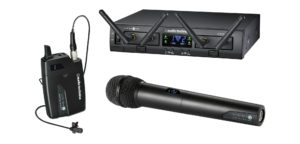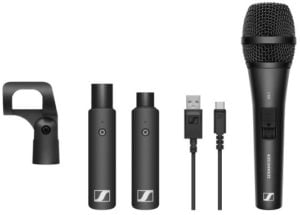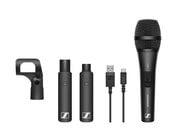One of the most common questions I hear from both pastors and worship leaders is whether to use wired or wireless microphones. However, there’s no one-size-fits-all answer, because there are always pros and cons to using any kind of wireless device. So, let’s look at some examples of when a wired device (microphone or in-ear monitor Definition:
Definition:
1. (audio) A loudspeaker or headphone/earphone used for accurate reference monitoring for recording or broadcast. 2. (live performance) A device that reproduces sound, like an in-ear monitor or speaker wedge, so performers can hear themselves. See: IEM. 3. (computers) A device that provides a graphic representation of operations occurring inside the computer. 4. (video) A device that enables seeing what is occurring with a video shoot, or program material from a broadcast or other video media source.) is a better choice over wireless, and when wireless would be the best option.
When to Use Wireless
The freedom to roam is the primary reason to go wireless, so if you need that kind of freedom, you need to at least consider a wireless device. However, even before choosing a wireless over wired system, you need to decide on the optimum microphone type—do you want a hand-held, lapel, lavalier, or headset Definition:
Definition:
A headphone with boom microphone for intercom, communications, learning labs, gaming, or sportscasting. type for the pastor? And what about the guitarist—should you choose a wired connection, or a wireless body pack?
You also need to decide if you want a dynamic (moving-coil Definition:
Definition:
(slang) Inductor; its derivation is that most inductors are made up of coils of wire.) mic, or a condenser Definition:
Definition:
An archaic term for Capacitor. type, as well as the polar pattern Definition:
Definition:
A graphic representation illustrating in positional degrees the sensitivity or radiation of a microphone, speaker, or antenna. (i.e., whether it picks up sound only from certain directions—a cardioid Definition:
Definition:
A microphone's heart-shaped directional pickup pattern. response—or everywhere, called an omni Definition:
Definition:
(jargon) Short for Omnidirectional. See: Omnidirectional. response). The microphone that might be optimum for your application may not be available in a wireless version, so it makes sense to decide on the appropriate microphone first, and then figure out whether wireless is an option for that type of mic. Here are some additional points to consider.
- If the person using the microphone or in-ear monitor is stationary, there’s no compelling reason to go wireless. For example, a keyboard player or drummer is typically sitting or standing in the same place, so your church could save money by using a wired device.
- It may not be necessary for all of your background vocalists to each have their own wireless mic. You may want to group a small choir around a wired microphone or two (this also provides a mix of the singers). Individual wired microphones on stands might be another solution.
- I’ve seen worship leaders with a wireless microphone
 Definition:
Definition:
A microphone with a transmitter that sends radio-frequency signals to link wireless with a receiver, obviating the need for a cable. standing motionless in front of their floor monitor. Because they’re essentially tethered to the wedge Definition:
Definition:
A monitor speaker for performers that sits on the floor, and whose speakers are angled up so that sound waves are localized to the performer. in order hear the mix, they don’t have the freedom to roam anyway. - If you want the talent to be 100% mobile, complete the circle by making everything Use wireless in-ear monitors, wireless guitar transmitters, and wireless microphones. Now they can move wherever they need to while playing, singing, and hearing their mix (and without trailing a lot of cables around).
- XLR-to-wireless adapters are available so you may be able to use your favorite mic, but not all can provide the 48V of phantom power
 Definition:
Definition:
A source of power for a microphone (usually condenser) that travels to the microphone over the microphone's cable. There are different voltage standards and requirements for different microphones, but the most common standard is 48 Volts. It derives its name because there is no visible power cable. (typically from a mixer Definition:
Definition:
Combiner, controller, and router for multiple audio or video signals.) that powers a traditional condenser mic. If you have this kind of adapter, a condenser mic would need to be non-wireless.
Setup Speed and Efficiency
Faster setup time is often given as a valid reason to use wireless systems—connect the wireless rack Definition:
Definition:
A frame for holding gear that meets an industry standard for enclosures. This specifies a 19 inch width, and a height that is some multiple of 1.75 inches. A rack frame can be open or enclosed, and has rails drilled with standardized screw holes for attaching rack equipment. to your mixer, hand out the transmitters, and you’re ready to rock. Not having to cable everything or uncoil/coil a snake Definition:
Definition:
A cable with multiple internal cables in a common jacket., which is common in portable church setups and teardowns, is very efficient.
However, don’t forget to factor in the time required to test battery Definition:
Definition:
An assembly of series-wired cells that provides higher voltages than individual cells. levels, install new or freshly charged batteries if needed, find frequencies that work (although this is much less of an issue with modern systems), and set up the antennae. Turning on a wireless system—especially an older analog Definition:
Definition:
A signal that is continuous in nature, as opposed to being defined as a series of discrete numbers (or elements) as found in digital signals; electrically "analogous" to an acoustical signal in the air. one—and having it work properly will require some homework, so be prepared. However, manufacturers are researching and developing wireless systems that make this process easier and more affordable. For example, the System 10 technology by Audio-Technica (Fig. 1) is a fine example of wireless technology that’s sonically pure, easy to set up, and affordable for even small houses of worship.

Also be on the lookout for bundles, which are often less expensive than buying multiple individual elements. For example, Sennheiser’s XSW-D Vocal Set (Fig. 2) bundles together elements from the Sennheiser XS Digital Definition:
Definition:
A signal or data expressed as series of the digits 0 and 1, typically represented by values of a physical quantity such as voltage or magnetic polarization. Wireless ecosystem to create a package that’s optimized for vocals. This is just one of several bundles; see the in-depth Definition:
Definition:
The extent to which one parameter modulates another. Increasing depth increases the effect of modulation. review of the XS Wireless Digital system for more details.

Incidentally, dealing with batteries was a far bigger problem ten years ago than it is now; improved rechargeable battery technology is one reason that wireless systems are increasing in popularity. Furthermore, rechargeable batteries can save you hundreds of dollars a year compared to buying the disposable kind. In my experience, Ansmann manufactures the best rechargeable batteries and battery chargers (Fig. 3).

What About Aesthetics?
Nobody wants to see cables, or trip over them—clean stages are uncluttered to look at and safe. But even if you don’t go wireless, you can still hide cables. Tape them down with carpet-matching gaffer's tape from Rose Brands. There are many other ways to address this, so spending hundreds of dollars more on a wireless system so that you don’t see wires may not make economic sense. Then again, if you find yourself needing a microphone while standing in a baptism pool, use a wireless microphone just in case there’s current in the water from a faulty ground Definition:
Definition:
A common zero-volt potential connection, commonly used for both electrical noise control and safety, and usually connected to the ground of the earth through a spike, plumbing, or electrical wiring that leads eventually to an earth connection. AKA: Earth.. I don’t know of anybody who has been electrocuted when using a wireless microphone.
Strengths and Limitations of Wired and Wireless Microphones
Fidelity. Wired mics will sound better than analog wireless systems using an equivalent quality mic, because analog wireless technology uses a process called companding Definition:
Definition:
The process of increasing dynamic range and lowering the noise of a recording or transmission system. See Compansion. to squeeze your audio signal into wireless audio’s limited bandwidth Definition:
Definition:
A range of frequencies that a device can generate, reproduce, or process. This usually implies little or no alteration within the range.. However, digital wireless systems are different, because they don’t need to compand the sound—the sound is equal to a wired mic, and can even be better if the wired mic’s cable is picking up hum Definition:
Definition:
An undesired continuous signal caused by AC electrical power, typically 60/50 Hz and its harmonics. or noise.
Range. Any system’s signal strength will be more likely to deteriorate with longer ranges. With wired mics, the only limit to reasonably long ranges is being more prone to picking up interference and potentially, losing signal strength. Analog wireless can go haywire when a mic starts to get out of range, which causes the system to alternate between receiving and dropping the signal. Fortunately, digital systems don’t have this problem—either they work, or they don’t. If they don’t, they just go silent.
Selection. Not every microphone that you may want/need is available in a wireless format.
Reliability. This is a mixed bag. A wired mic is making a direct connection, so it should be (and almost always is) more reliable than wireless. But cables go bad, get stepped on, are tripped over, and the like. Wireless microphone batteries can run out of juice. So no matter what technology you use, you need to keep on top on it.
Setup issues. This is pretty much exclusive to wireless. The transmitter Definition:
Definition:
Any device that sends an electrical signal, typically radio waves or by wire. needs to see the receiver antenna Definition:
Definition:
A device for radiating or receiving electromagnetic signals. for best results, the batteries must have the correct voltage Definition:
Definition:
Also called electro-motive Force (EMF). The "charge potential" or pressure of electrons that causes current to flow in a circuit., receivers shouldn’t be adjacent to digital devices (computers, DVD Definition:
Definition:
DVD (Digital Video Disc): A playback format for video/audio data, typically capable of holding about 4.7 GB for a single-sided disc, and over 8 GB of data for a double-sided one. players, digital reverbs, etc.) whose radiation can interfere with your wireless setup, and the wireless frequencies can’t interfere with local TV stations and other wireless systems (assisted listening devices, intercoms, etc.) at your location. If there are multiple, interfering wireless devices within range, most devices—from computer modems, to headphones, to TVs to phones—work better with wired connections.
Expense. A wireless system could cost at least two to three times more than the same brand/model of a wired device.
Wireless frequency Definition:
Definition:
A value, expressed in Hertz, that indicates how many cycles of a periodic signal occur in one second. band Definition:
Definition:
A grouped range of frequencies, usually with a commonly used designation. issues. Our own Federal Communications Commission likes to sell off TV band spectrum (the frequencies that we the public, as wireless users, have been able to access for years) to private telecommunications entities. You remember the 700 MHz Definition:
Definition:
Abbreviation for Megahertz. 1,000,000 Hertz, or one million cycles per second. sale, and how it made some of our wireless devices illegal? In 2017, the 600 MHz band was up for sale, and took away large pieces of what we used for wireless mics. For new gear Definition:
Definition:
Musical or performance equipment., manufacturers can confirm whether a wireless mic is in compliance Definition:
Definition:
1. The behavior of a loudspeaker driver's suspension. 2. A phonograph cartridge's ability to follow rapid changes in a groove. 3. Adherence to a system's requirements for operation. For example, a device that is compliant with the USB (Universal Serial Bus) specification does not need a custom driver. with the latest government regulations. For second-hand gear... you’re pretty much on your own. Fortunately, a lot of the most affordable, easy-to-use systems transmit over the 2.4 GHz Definition:
Definition:
Abbreviation for Gigahertz, which equals 1,000,000,000 cycles per second. band, and that band is not likely to change for a long time (if ever).
Wireless Continues to Improve
Manufacturers have been developing technologies that will work in the ever-changing technological landscape, and digital wireless is coming of age. Not all digital wireless systems are equal, or deliver the same quality, so do your due diligence when researching how these systems operate. And of course, line-of-sight operation remains crucial for getting the maximum range, so make sure that your transmitters can see the receivers. In any event, Full Compass specializes in House of Worship audio, and keeps up on the latest technologies. Their expert sales people can point you in the right direction.
Also, note that most newer devices operate outside of the TV bands. It’s easier to coordinate your transmitters with frequencies that work, almost like pairing a Bluetooth Definition:
Definition:
A short distance (less than 33 feet) wireless data transfer standard. device—and you can add more mics easily to an existing wireless systems without having to re-coordinate. The sonics in many of them rival wired systems because they are transmitting digital 1s and 0s, not analog signals that are subject to degradation. And like so much digital technology, prices continue Definition:
Definition:
A MIDI message that tells drum machines, sequencers, etc. to continue playing from the current location if they have been stopped previously by a Stop message. to fall. Systems are not only becoming better, but more affordable.
So What’s Best?
Ultimately, a mix of wired and wireless may very well be the best way to go. If someone doesn’t need to move around, wired mics work and save money. But for those who need freedom to roam, wireless mics provide that freedom—and can make for a more compelling service (or corporate presentation, for that matter).
Now that you understand the most important considerations, it’s time to do some homework. Wireless and wired both have their advantages, so all you need to do is make sure you’re using the right tool for the right job.

















